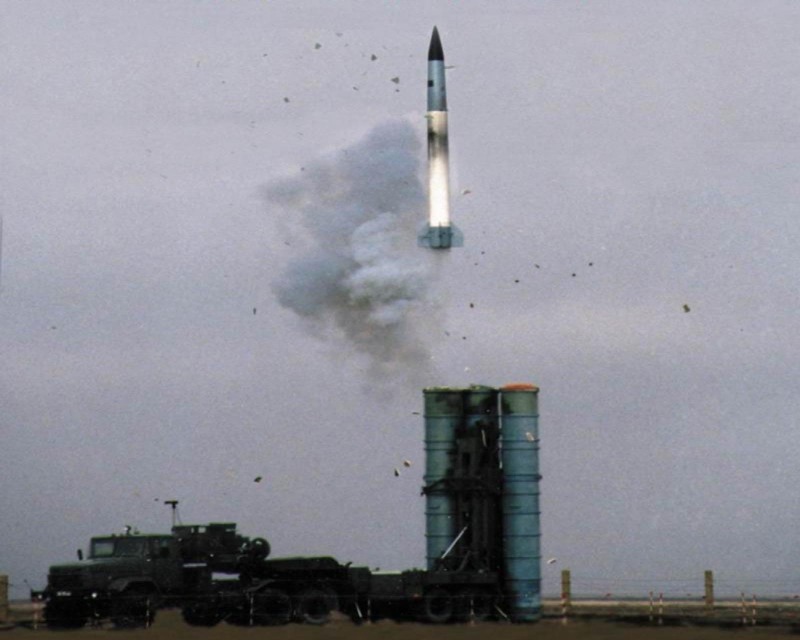|
||||||||||||||||||||||
![Home - Air Power Australia Website [Click for more ...]](APA/APA-Title-Main.png) |
||||||||||||||||||||||
![Sukhoi PAK-FA and Flanker Index Page [Click for more ...]](APA/flanker.png) |
![F-35 Joint Strike Fighter Index Page [Click for more ...]](APA/jsf.png) |
![Weapons Technology Index Page [Click for more ...]](APA/weps.png) |
![News and Media Related Material Index Page [Click for more ...]](APA/media.png) |
|||||||||||||||||||
![Surface to Air Missile Systems / Integrated Air Defence Systems Index Page [Click for more ...]](APA/sams-iads.png) |
![Ballistic Missiles and Missile Defence Page [Click for more ...]](APA/msls-bmd.png) |
![Air Power and National Military Strategy Index Page [Click for more ...]](APA/strategy.png) |
![Military Aviation Historical Topics Index Page [Click for more ...]](APA/history.png)
|
![Intelligence, Surveillance and Reconnaissance and Network Centric Warfare Index Page [Click for more ...]](APA/isr-ncw.png) |
![Information Warfare / Operations and Electronic Warfare Index Page [Click for more ...]](APA/iw.png) |
![Systems and Basic Technology Index Page [Click for more ...]](APA/technology.png) |
![Related Links Index Page [Click for more ...]](APA/links.png) |
|||||||||||||||
![Homepage of Australia's First Online Journal Covering Air Power Issues (ISSN 1832-2433) [Click for more ...]](APA/apa-analyses.png) |
||||||||||||||||||||||
| Last Updated: Mon Jan 27 11:18:09 UTC 2014 | ||||||||||||||||||||||
|
||||||||||||||||||||||
Theatre Ballistic Missile Defence Systems |
| by
Dr Carlo Kopp, AFAIAA, SMIEEE, PEng July 2008 Updated April, 2012 Text, Line Art © 2008 - 2012 Carlo Kopp |
 THAAD launch (US DoD). |
|
IntroductionBallistic missiles and cruise missiles are the most rapidly growing category of offensive weapon in Asia, in response to which we are seeing increased planning for investment in defensive measures. The recent announcement that Japan and Australia were likely to participate in a feasibility study on ballistic missile defences, and Japan's overt pursuit of the F-22A Raptor fighter for cruise missile defence, are both indicators of a developing trend. |
Regional Theatre Ballistic Missile CapabilitiesThe biggest user of ballistic missiles in Asia is the China, followed by North Korea, India, and Pakistan. The most numerous weapons are theatre oriented, either Tactical Ballistic Missiles (TBM) or Intermediate Range Ballistic Missiles (IRBM), with Inter Continental Ballistic Missiles (ICBM) operated by China and being developed by India and North Korea. China operates a wide range of weapons. Legacy weapons include the DF-3/DF-3A (2800 km), DF-4 (4,750 km), and the DF-5/DF-5A (13,000 km). TBMs include the M-7 (160 km), DF-11/M-11 (300 km), the DF-15/M-9 (500 km), the primary IRBM and SLBM is the DF-21/JL-1 series (1,800 km), supplemented by the DF-25 (1,800 km). Modern ICBMs include the developmental DF-31 and DF-41 series. There are claims China is adapting the DF-21 with terminal guidance as an anti-shipping weapon. India's capabilities are modest in comparison, and include the Prithvi TBM in three variants, with ranges between 150 and 350 km, and the navalised Dhanush with 250 km class range, recently tested. IRBM capability is provided by the Agni I (900 km) and Agni II (1,800 km). The Agni III is a developmental ICBM derivative. Pakistan has been very active in developing TBMs and IRBMs, mostly based on Chinese and North Korean technology. The indigenous Hatf 1 and 2 spans ranges between 100 and 280 km, the M-11 Shaheen, M-9 Shaheen I and the M-18 Shaheen II are Chinese technology, and the Ghauri I is an IRBM based on the Korean No-Dong. The DPRK has been very active in developing IRBM and ICBM technology, as part of its long running strategy of extracting concessions by WMD blackmail of regional powers. The regime has also been a primary supplier to Iran, and partly to Pakistan. The DPRK has three families of missiles, based on the R-11/SS-1 Scud, the R-21/SS-N-5 Sark, and the R-27/SS-N-6 Serb. The Hwa-Song 5 and 6 are stretched Scud B/C/D TBMs, the No Dong A IRBM a derivative of the Soviet R-21, and the No Dong B the Soviet R-27. The Taepo Dong 1 and 2 are three stage ICBM growth variants of the No Dong series, with the capability to reach the US or Australia. |
 DF-3 ballistic missile being elevated for launch (PLA).  DF-4 ballistic missile elevated (PLA).  DF-5 being readied for launch (PLA).  DF-5 launch (PLA).  DF-11 TEL on WS-2400 chassis (PLA).   DF-15 TEL on parade (PLA).  DF-21C/D self-proelled TEL/Transporter (PLA).  DF-21A legacy TELs on parade (PLA). 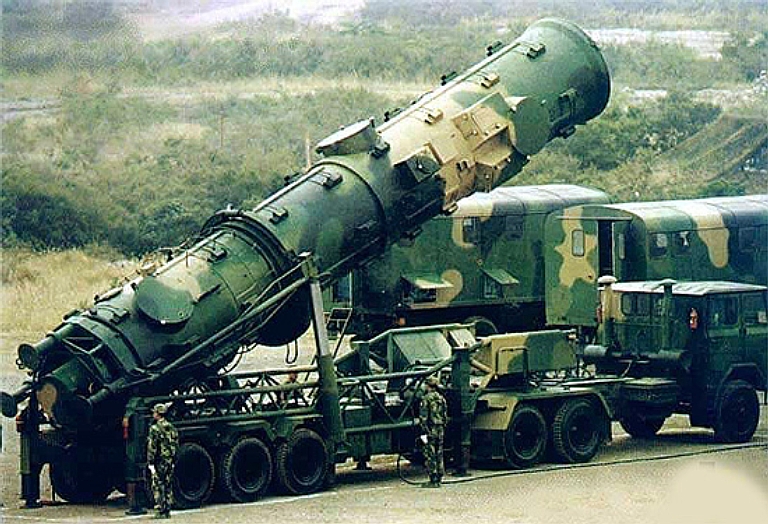 DF-21A legacy TEL elevating (Xinhua). 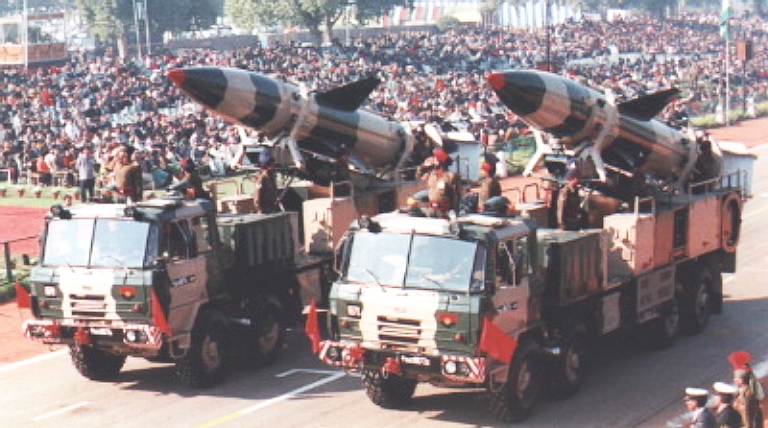 Prithvi 150 TBMs (DRDO).   Prithvi 250 TEL (DRDO).  Agni II on parade (Antônio Milena - Agência Brasil) |
Defending Against Ballistic MissilesThe best defensive strategy against all standoff missiles, be they ballistic or cruise missile class weapons, is to pre-emptively attack and destroy the launch platform. This was true in 1944 when the first V-1 and V-2 weapons were deployed and remains true today – 'killing the archer rather than the arrow'. This is unfortunately easier said than done, and counterforce air strikes against mobile missile launchers have been bedevilled with targeting problems since 1944 – the US Air Force effort against Saddam's Scud force in 1991 represents the most recent example. With ballistic and cruise missiles more recently deployed on submarines and surface warships, the problem gains a further dimension. Ground based mobile launchers however represent the greatest difficulty, as these are highly mobile and easily concealed. Users favour the 'shoot and scoot' strategy, and tracking weapons post launch leaves a very narrow time window to locate and kill the launcher before it departs. Interception of both cruise missiles and ballistic missiles in flight is challenging, and it is an open question as to which is the more difficult target. Ballistic missiles are characteristically easy to detect and track once launched, but their hypersonic terminal phase velocity represents a real problem for defensive weapon systems. The problem is often described as 'hitting a bullet with another bullet', and the problem increases in difficulty as the range of the missile and its terminal velocity increase. Killing a Scud B is easier than killing an IRBM, and killing an IRBM in turn is easier than killing an ICBM. Three strategies are possible for interception of ballistic missiles. Boost phase intercept sees the slow moving and highly visible by exhaust plume missile attacked, midcourse phase intercept sees the warhead and if attached, final stage attacked at the apex of its trajectory, and terminal phase intercept involves engagement of the warhead section as it dives on the target. Boost phase intercept is the easiest from a detection, tracking and kinematic perspective. The exhaust plume can be seen from orbit, and hundreds of kilometres away in the air. The missile is climbing at a supersonic speed, and early in the boost phase, will have all of its stages attached presenting a large radar target. The difficulty with boost phase intercept is that the defending aircraft, be it equipped with an interceptor missile or directed energy Weapon (DEW), must be near enough to the launcher to effect a timely shot. Where the missile user has good 'anti-access' capability, via Surface to Air Missiles (SAM) and fighter aircraft, this becomes a challenging problem. Much of the justification for the design of the stealthy Northrop B-2A Spirit bomber was the hunting of highly mobile Soviet ICBM launchers. Fighters equipped with interceptor missiles are presented with a high risk environment in which they must orbit for many hours awaiting unpredictable ballistic missile launches, either to effect a boost phase shot, or to kill the launcher. Mid course phase intercepts are arguably the most challenging from a detection and tracking perspective, as the missile is at the peak of its trajectory, and having shed booster stages is a small and cool radar target. Kinematically, mid course phase intercepts are demanding in terms of altitude, even if the missile's speed is modest as it flies across the top of the ballistic arc. Terminal phase intercepts sees the delivery vehicle produce a prominent ionisation trail and heat signature, as ablative coatings evaporate during re-entry. The ionisation plume provides a radar signature much larger than the vehicle itself, permitting a tracking system to cue precisely to the position of the warhead. The principal tracking challenge is discrimination between the re-entry vehicle and debris or countermeasures re-entering concurrently. The latter proved a major issue for Patriot intercepts of the Scud in 1991. Kinematics then become the primary challenge for a defender's missiles. Cruise missile defence is conceptually simpler, but technically no less difficult. This is because cruise missiles are low signature targets, with small radar cross sections in most bands and cool exhausts mostly – only supersonic cruise missiles have an appreciable heat signature. Flying low altitude terrain following profiles, cruise missiles are often routed to take advantage of terrain to further effect terrain masking, and hide the missile in the radar shadow of valleys and hills. Radars with high power aperture performance, usually in the X-band, are the sensor of choice for hunting cruise missiles. While in principle any air to air or surface to air missile can be used for this purpose, in practice fusing and seeker modifications are typically required to provide a high kill probability. |
Ballistic Missile Defence SystemsAt this point in time a number of systems are deployed or in develop to effect engagements against ballistic missiles. 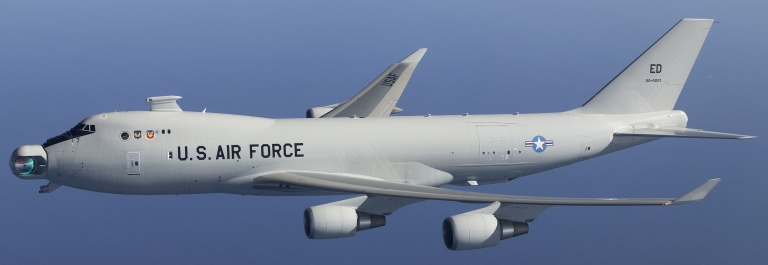 YAL-1A in flight (U.S. Air Force) USAF YAL-1A AirBorne Laser System [Click for more ...]The technologically most advanced system at this time is the cancelled Boeing/USAF YAL-1A Air Borne Laser system, a 2 MegaWatt Chemical Oxygen Iodine Laser (COIL) DEW carried by a modified Boeing 747-400F airframe. The weapon was being developed to effect boost phase engagements against TBMs, IRBMs and ICBMs from ranges of up to 400 km. The US aim was to deploy a small fleet of these aircraft to patrol the borders of rogue states, like the DPRK or Iran, and destroy any ballistic missiles which might be launched, resulting in their WMD payloads falling back on the territory of origin. The ABL was a challenging program with ambitious goals, as the turbulent and particle laden atmosphere is a difficult propagation environment for the 1.315 micron laser beam to penetrate over a distance. The ABL uses a pilot beam laser to illuminate the target, and a Hartmann-Shack wavefront sensor to generate beam wavefront distortions, intended to compensate for atmospheric effects. Problems encountered to date include the 'firefly' effect, where atmospheric dust particles floating in the beam are partly vapourised, producing supeheated gas plumes and further disturbing the propagation environment. The program was in the development phase, with funding for production systems contingent on the success of the development article, when funding was cut in 2010, and the programmed cancelled in late 2011, as the US defence budget collapsed.  Raytheon's
NCADE is a two stage Anti Ballistic Missile boost phase interceptor
derived from the AIM-120 AMRAAM. The first stage is an AMRAAM motor,
the second stage sustainer uses a high energy liquid propellant
hydroxylammonium
nitrate motor, with a hydroxylammonium
nitrate four nozzle control thruster system (Raytheon images).
 Air Launched Hit-to-Kill / NCADEThe Air Launched Hit-to-Kill system is a less ambitious proposal for a less capable boost phase system, which involves equipping a late model F-15C with the APG-63(V)3 phased array radar and a derivative of the Patriot PAC-3 interceptor missile. The Missile Defence Agency awarded a study contract early in 2007. There are no reports as yet of a Russian analogue to this system, involving integration of the 9M96E/E2 missile with the Su-30/35 Flanker, although the Novator R-172 with similar size and performance is being integrated on the Su-35BM. To date most investment has however been put into terminal phase intercept weapons, some of which provide a limited midcourse intercept capability.
48N6 Missile
Launch
(Almaz). Almaz-Antey S-300PMU1/PMU2/S-400 Gargoyle/Growler [Click for more ...]Russia is currently marketing two families of ABM system, based on the S-300PMU/S-400 Grumble/Gargoyle system, and the S-300V/VM Giant/Gladiator system. While both share their early origins during the 1970s, they are unique missile systems with different radars, missiles and guidance systems. The S-300PMU-1/PMU-2 provide some ABM capability akin to that in the early Patriot PAC-1 series, with variants of the 48N6 missile guided by the L-band 64N6E Big Bird acquisition radar and the X-band 30N6E Flap Lid engagement radar, the latter an analogue to the US MPQ-53 Patriot radar. With the transition to the newer S-400 variant, the 9M96E/E2 interceptor missiles were introduced, and radar enhancements added, to provide an ABM capability similar to the PAC-3. All weapons use Track Via Missile (TVM) guidance similar to the Patriot series. The system has been actively marketed in the ABM role.  S-300V Battery components, above left to right, 9A83 TELAR, 9A84 TEL/TL with crane elevated, 9A82 TELAR, below left to right, 9S15 Bill Board acquisition radar, 9S457 CP and 9S32 Grill Pan engagement radar. Almaz-Antey S-300V Gladiator and Antey 2500/S-300VM [Click for more ...]The alternative is the Antey 2500 or S-300VM, an enhanced PVO-SV S-300V system, armed with the hypersonic 9M82 and 9M83 missiles, guided by the 9S19M Imbir / High Screen acquistion radar and the 9S32M Grill Pan engagement radar. The missiles use semiactive continuous wave homing, with illuminators on each TEL. Unlike the S-300PMU/S-400 series which evolved from killing aircraft to an ABM, the S-300V was designed from the outset as an ABM, to the extent that the specialised High Screen ABM radar is used. Both the S-300V and the S-300PMU-2/S-400 are highly mobile weapon systems, equipped with radio datalinks to connect battery elements.  MIM-140
PAC-2 Patriot launch (US DoD).
Raytheon MIM-104 Patriot PAC-1/2/3The US competitor to the S-300PMU/S-400 and S-300VM is the MIM-104 Patriot supported by the MPQ-53 family of acquistion and engagement radars. The Patriot MIM-104B PAC-1 with limited ABM capability via warhead and fusing modifications was introduced during the late 1980s, and used during the 1991 Gulf War with widely disputed success. The further improved MIM-104C PAC-3 was also deployed during the 1991 conflict. It was followed in 1994 by the MIM-104D PAC-2/GEM (Guidance Enhanced Missile) system, since to be replaced with the enhanced MIM-104E GEM+ system, with further missile modifications. The most recent variant is the PAC-3 variant, in three consecutive configurations, the latest of which includes the revised MPQ-65 radar and the Lockheed Martin ERINT (Extended Range Interceptor) missile. The ERINT is a US analogue to the Russian 9M96 series, a compact and agile missile with Ka-band active seeker and thrusters.  PAC-3
(ERINT) launch (US DoD).
 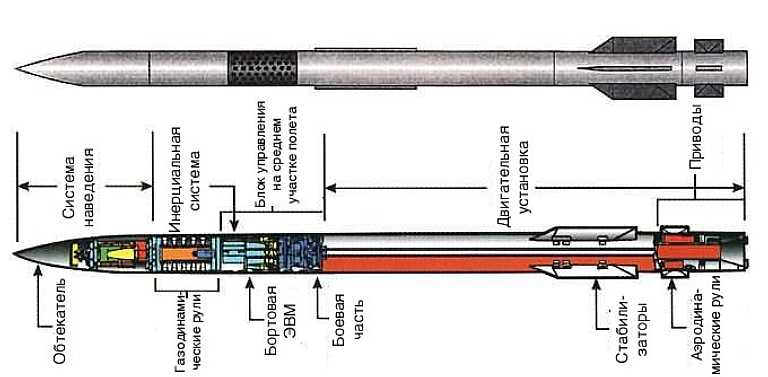 The PAC-3 is to provide the lower and mid altitude component of a layered defensive system, where the upper coverage would be provided by the THAAD (Theatre High Altitude Area Defense) system.  THAAD
TEL (above) and TPY-2 engagement radar (below).
 Theatre High Altitude Area Defense SystemThe THAAD employs the Raytheon Systems AN/TPY-2 X-band Ground-Based Radar (GBR), a 9.2m² phased array with 25,344 solid-state X-band transmit and receive modules and a cited range of up to 1,000 km. The THAAD missile is a two stage design using a Kinetic Kill Vehicle (KKV), equipped with a liquid fuelled manoeuvring system and imaging thermal seeker. A typical battery uses 9 M1075 Oshkosh Truck Corporation Heavy Expanded Mobility Tactical Truck with Load Handling System (HEMTT-LHS) as TELs and a single towed AN/TPY-2 radar.   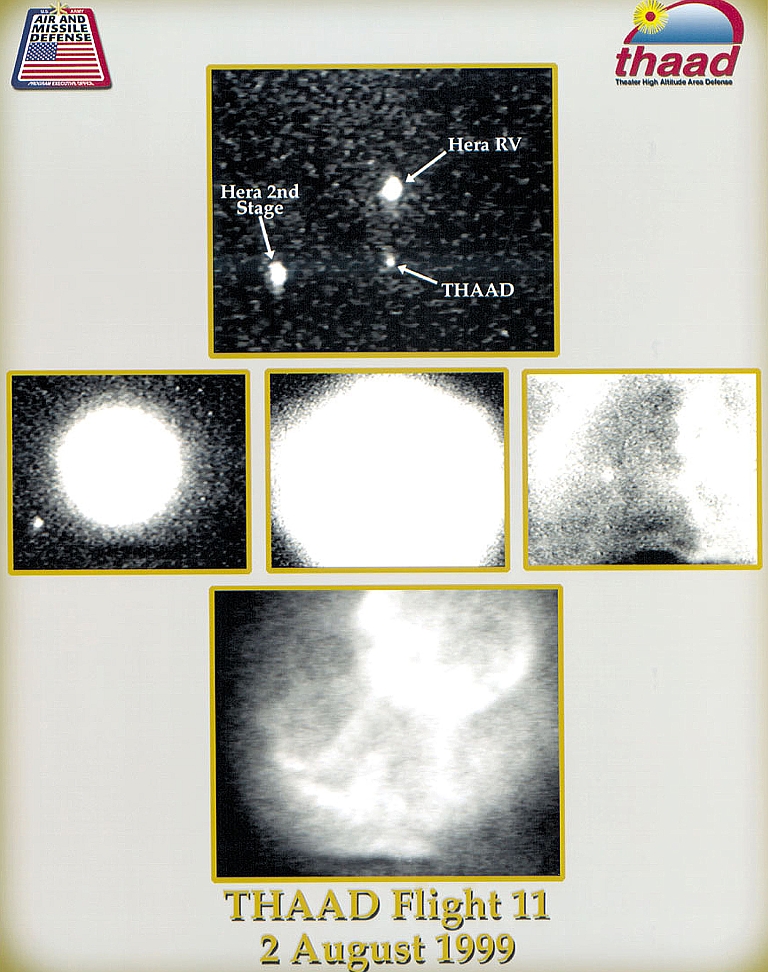 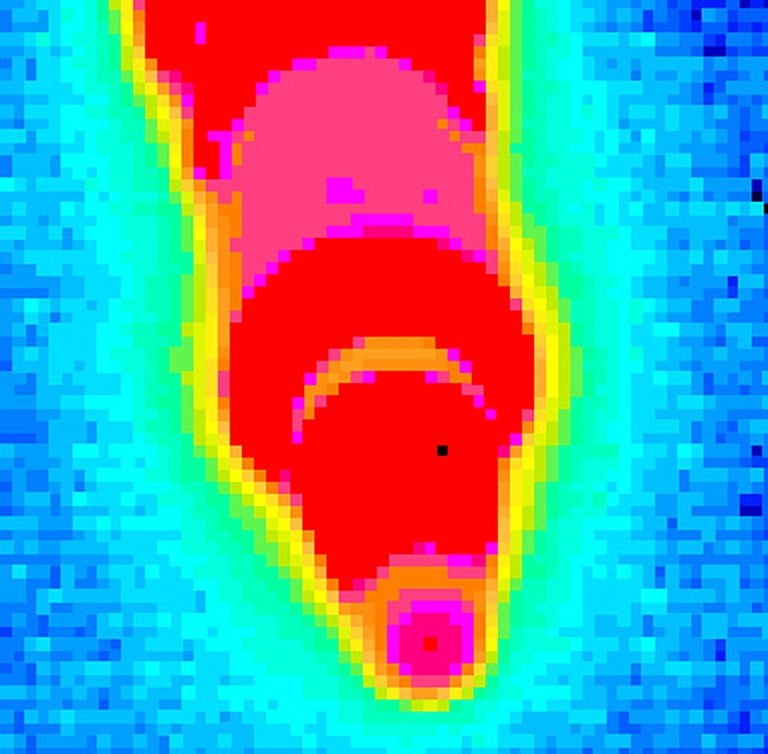 THAAD
Seeker image (US DoD).
 IAI
Arrow launch (IAI).
IAI Green Pine / Arrow SystemThe Israeli competitor to the THAAD is the Green Pine / Arrow system. The Elta EL/M-2090 Green Pine is a phased array acquisition and engagement radar, which guides the two stage IAI Arrow 2 ABM. The hypersonic missile is equipped with an active radar and infrared seeker.  Green
Pine engagement radar for Arrow ABM (IAI Elta).
 Raytheon RIM-161 Standard SM-3The US Navy is the final big player in this market with a planned two layered system built around the SPY-1 Aegis radar, and two variants of the Standard series missile. The NTW-TBMD (Navy Theater Wide - Theater Ballistic Missile Defense) was to use the RIM-156 Standard SM-2ER Block IV missile for lower altitude engagements, and the Raytheon RIM-161 Standard SM-3 for high altitude engagements. With the cancellation of the RIM-156 capability the system is now centred on the RIM-161, which uses a new booster, and a LEAP (Lightweight Exo-Atmosspheric Projectile) infrared guided terminal vehicle. 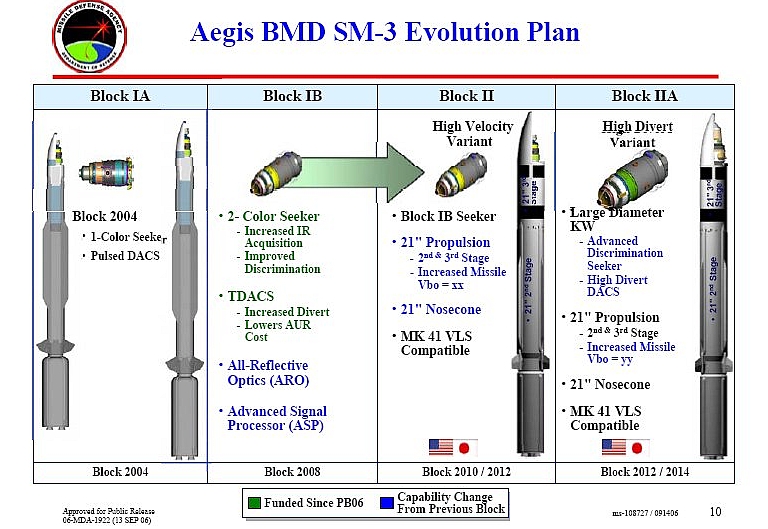  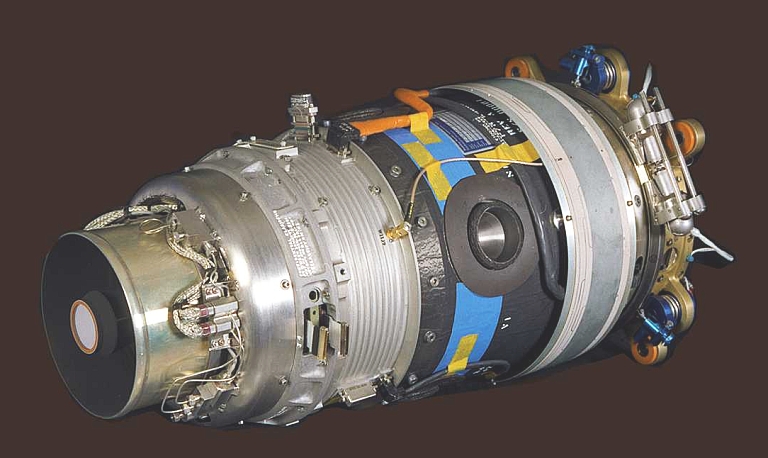 RIM-161/SM-3 LEAP infrared seeker module (US DoD). 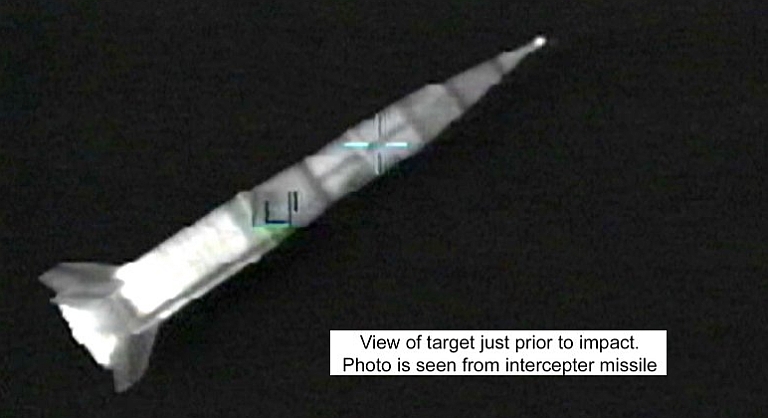 |
 THAAD
(US DoD).
|
References
|
Line Artwork: © 2000, 2007, 2008 Carlo Kopp |
|
Technical Report APA-TR-2008-0701 |
|
|||||||||||||
![Sukhoi PAK-FA and Flanker Index Page [Click for more ...]](APA/flanker.png) |
![F-35 Joint Strike Fighter Index Page [Click for more ...]](APA/jsf.png) |
![Weapons Technology Index Page [Click for more ...]](APA/weps.png) |
![News and Media Related Material Index Page [Click for more ...]](APA/media.png) |
||||||||||
![Surface to Air Missile Systems / Integrated Air Defence Systems Index Page [Click for more ...]](APA/sams-iads.png) |
![Ballistic Missiles and Missile Defence Page [Click for more ...]](APA/msls-bmd.png) |
![Air Power and National Military Strategy Index Page [Click for more ...]](APA/strategy.png) |
![Military Aviation Historical Topics Index Page [Click for more ...]](APA/history.png)
|
![Information Warfare / Operations and Electronic Warfare Index Page [Click for more ...]](APA/iw.png) |
![Systems and Basic Technology Index Page [Click for more ...]](APA/technology.png) |
![Related Links Index Page [Click for more ...]](APA/links.png) |
|||||||
![Homepage of Australia's First Online Journal Covering Air Power Issues (ISSN 1832-2433) [Click for more ...]](APA/apa-analyses.png) |
|||||||||||||
| Artwork, graphic design, layout and text © 2004 - 2014 Carlo Kopp; Text © 2004 - 2014 Peter Goon; All rights reserved. Recommended browsers. Contact webmaster. Site navigation hints. Current hot topics. | |||||||||||||
|
Site Update
Status:
$Revision: 1.753 $
Site History: Notices
and
Updates / NLA Pandora Archive
|
|||||||||||||
|
|
Tweet | Follow @APA_Updates | |||||||||||
|
|
|||||||||||||
|
|
|||||||||||||
![F-111 Aardvark Index Page [Click for more ...]](APA/f-111.png)
![F/A-18 Hornet and Super Hornet Index Page [Click for more ...]](APA/fa-18a.png)
![Aerial Refuelling and Airlift Capabilities Index Page [Click for more ...]](APA/aar-lift.png)
![Directed Energy Weapons and Electromagnetic Bombs Index Page [Click for more ...]](APA/dew.png)
![Notices and Updates Index Page [Click for more ...]](APA/notices-128.png)
![APA NOTAM and Media Release Index Page [Click for more ...]](APA/notams-128.png)
![APA Research Activities and Policy / Technical Reports Index [Click for more ...]](APA/research-128.png)
![Search Air Power Australia Website [Click for more ...]](APA/search-128.png)
![Briefings and Submissions - Air Power Australia [Click for more ...]](APA/briefs-128.png)
![Air Power Australia Contacts [Click for more ...]](APA/contacts-128.png)
![Funding Air Power Australia [Click for more ...]](APA/funding-258.png)
